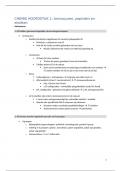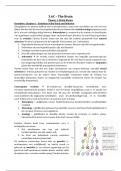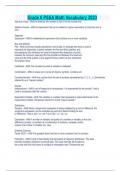Hoofdstuk 16 – The nature of qualitative research
16.1 Introduction
Qualitative research is a type of research strategy that emphasizes words, images, and objects when
collecting and analysing data. It is broadly inductivist, constructionist, and interpretivist, but it can
take a variety of forms: qualitative researchers do not always subscribe to all three of these features.
16.2 What is qualitative research?
Qualitative research aims to generate deep insights concerning particular topics, and it does this
through a considered engagement with places and social actors. Aside from the focus on words,
images and objects, the key features of qualitative research are:
- An inductive view of the relationship between theory and research, with the former
generated out of the latter.
- It is interpretivist in nature (an epistemological position), meaning that it tries to generate
an understanding of the social world by examining how its participants interpret it.
- It has an ontological position that we describe as constructionist, in that social properties
are seen as outcomes of the interactions between individuals rather than phenomena that
are ‘out there’ and separate from those involved in constructing them.
It is often difficult to describe qualitative research with precision. There are three key reasons for
this:
1. The term ‘qualitative research’ is sometimes taken to imply that it is a research strategy that
does not involve any quantitative data, but the absence of numbers is not the distinctive
aspect of the strategy.
2. There are different traditions and perspectives within qualitative research, and there is often
significant variation between approaches.
3. Qualitative research is often discussed in terms of the ways in which it differs from
quantitative research, which can mean that it is addressed in terms of what it is not rather
than what it is.
Traditions and perspectives in qualitative research
Denzin and Lincoln have suggested that qualitative research has progressed through eight significant
stages. However, these moments have to be treated with caution:
- They seem to present the moments as distinct, consecutive phases where one moment led
to another. The reality is that each ‘moment’ continued to develop and contemporary
qualitative research is actually still composed of all of these traditions.
- Some phases are strongly associated with particular events which looks strange given that
the earlier moments are each associated with several decades.
- The moments seem to be concerned with a shift in social research in general rather than
within qualitative research specifically.
- The list ends in the early 2000s and does not acknowledge the many new forms of and
perspectives within modern qualitative research that have emerged since. More recent
movements are:
i. An emphasis on the sensory
ii. A questioning of normative concepts of identity and experience
, iii. The use of creative and participatory approaches: these types of methods
attempt to rebalance power relations in research by conducting studies ‘by’
or ‘with’ rather than ‘on’ participants
Data-collection methods in qualitative research
The main methods of data collection associated with qualitative research are:
- Ethnography/participant observation
- Qualitative interviewing
- Focus groups
- The collection of texts and documents
Other, less widely used methods are available and studies can use more than one method (multi-
method approach). New ways of collecying and analysing coninue to be developed.
16.3 The main preoccupations of qualitative researchers
Quantitative and qualitative research can be seen as having a set of distinctive and contrasting
concerns. Their preoccupations reflect different beliefs about what kind of knowledge is acceptable
(this is called epistemology). Quantitative research is profoundly influenced by the natural sciences
in terms of what should count as acceptable knowledge, qualitative researchers are more influenced
by interpretivism. The five common concerns of qualitative researchers are:
1. Seeing through the eyes of those being studied
2. Providing full decriptions and emphasizing context
3. The importance of process in social life
4. Prioritizing flexibility
5. Grounding concepts and theory in data
Seeing through the eyes of the people being studied
Many qualitative researchers operate on the assumption that the subject matter of the social
sciences is different from that of the natural sciences. The key difference is that the objects of
analysis of the natural science cannot attribute meaning to events and to their environment, whereas
people can and do. Many qualitative researchers argue that we need a methodology for studying
people that reflects this difference, and express a commitment to viewing the social world through
the eyes of the people that they study. The epistemology underlying qualitative research has been
expressed as having two central principles:
1. Face-to-face interaction is the fullest condition of participating in the mind of another human
being.
2. You must participate in the mind of another human being to acquire social knowledge.
Therefore it is not surprising that many researchers say that understanding and conveying the views
of the people they study is the central focus for their research. The preference for seeing through the
eyes of the people studied often goes along with the closely related goal of probing beneath surface
appearances. In attempting to take the position of the people you are studying, you may find that
they view things in a different way from what you might have expected. The attempt to try to see
through the eyes of the participants strongly resonates with the goals of interpretivism. However,
this is not without practical problems, which include the risk of ‘going native’ and losing sight of what
you are studying, the problem of how far the researcher should go, and the possibility that the
researcher will be able to see through the eyes of some of the people but not others. These
difficulties are discussed in the following chapters.
,Because much qualitative research focuses on the perspectives of those being studied, many writers
argue that the kind of reasoning required is not inductive but abductive. Induction involves theory
emerging out of research, whereas abduction involves the researcher grounding a theoretical
understanding of the contexts and people they are studying in the language, meanings, and
perspectives that form that worldview. So any theory that emerges from the research should be
understandable to those people involved in the study. The crucial step in abduction is that, having
described and understood the world from participants’ perspectives, the researcher must come to a
social-scientific account of the social world from those perspectives. They must not lose touch with
the world as it is seen by those whose voices provided the data.
The importance of context
Qualitative researchers are much more likely than quantitative researchers to provide a lot of
descriptive detail when reporting their findings. Description is not their only focus. They also try to
provide explanation, and answer ‘why’ questions. Many qualitative studies provide detailed
descriptions of what goes on in the setting being investigated, called thick descriptions. The
researcher has to take care not to get too caught up in descriptive detail. Descriptive excess is when
the amount of detail overwhelms or interferes with the analysis of data. Qualitative researchers
argue that we cannot understand the behaviour of members of a social group without appreciating
the specific relations, networks, and environments in which they operate. The tendency to provide a
lot of description can also be seen as a manifestation of the naturalism (being true to the nature of
the phenomenon being investigated) that is central to much qualitative research and that places
great value on detailed, rich descriptions of social settings.
Emphasis on process
Qualitative research tends to view social life in terms of processes. This reveals itself in a number of
different ways, including the way that qualitative researchers try to show how events and patterns
unfold over time. Ethnographic research is particularly associated with this emphasis, and
ethnographers are typically immersed in a social setting for a long time. This means that they are
able to observe the ways in which events develop and/or the ways in which the different elements of
a social system interconnect. Such findings can help us see social life in terms of streams of
interdependent events and elements. However, ethnographers are not the only qualitative
researchers who can explore process within social life. Researchers can also examine process through
semi-structured and unstructured interviewing by asking participants to reflect on the processes
leading up to or following on from an event. These interview methods are discussed later.
Flexibility
Many qualitative researchers are critical of approaches to research that involve imposing
predetermined formats on the social world. This has to do with their preference for seeing through
the eyes of the people being studied. After all, if researchers use a structured method of data
collection (such as a structured interview with closed-ended questions), they must have made
decisions about what they expect to find and about the nature of the social reality that they will
encounter. This necessarily limits the degree to which the researcher can try to adopt the worldview
of the people being studied. Consequently, most qualitative researchers prefer a research orientation
that involves as little prior contamination of the social world as possible. Keeping some flexibility in
the ways they collect data also makes it more likely that research participants’ perspectives will be
revealed. Within ethnographic approaches, the preference for a less structured approach to data
collection often means that the investigator does not need to develop highly specific research
questions in advance. This allows researchers to submerge themselves in a social setting with a fairly
general research focus in mind, and then gradually develop a narrower focus by making as many
, observations of that setting as possible. They can then formulate more specific research questions
out of their collected data. Another advantage of taking a less structured approach is that it offers
more scope for flexibility. The researcher can change direction in the course of their investigation
much more easily than in quantitative research, which tends to have a built-in momentum once the
data collection is under way. Structured interviewing and structured observation can have some
flexibility, but this is limited by the requirement to make interviews as comparable to each other as
possible.
Concepts and theory that are grounded in data
In qualitative research, there is a tendency to take an inductive view of the relationship between
theory and research. Qualitative researchers usually develop concepts and theories using the data
that are collected during the research project. This differs from quantitative research, where
theoretical issues are usually seen as driving the formulation of research questions, which in turn
shapes how data is collected and analysed. Findings then feed back into the relevant theory. Within
qualitative research, the relationship between theory and data is more nuanced and ambiguous.
Theory can be both the starting point and the outcome of an investigation, rather than only
something that precedes it.
16.4 The main steps in qualitative research
Despite the variety in approaches associated with
qualitative research, it is possible to identify the
main steps that most of these studies involve (see
the picture on the right).
You can first do a pilot study (step 3). You can use
sensitizing concepts, terms that point to what is
relevant or important and that are used to guide an
investigation. The loop back from Step 5a to step 5b
implies that a theoretical position might emerge in
the course of research that prompts the researcher
to further collect data to reflect emerging issues of
interest that they had not initially foreseen.
16.5 Theory and concepts in qualitative research
When writing about the research process, most qualitative researchers emphasize a preference for
treating theory as something that informs and, at the same time, emerges out of data collection and
analysis. Other examples of inductive approaches where theory is generated from the data include
thematic analysis (Chapter 23), analytic induction (Chapter 23) and some forms of discourse
analysis (Chapter 21). Some researchers have also argued that qualitative research should be
developed according to particular theoretical approaches that help to define elements of a study,
including the research question(s) and the research design.
Concepts are part of the landscape in qualitative research. According to Blumer there are two types
of concepts that can be used for qualitative purposes: definitive concepts and sensitizing concepts.
Definitive concepts are typified by the way in which a concept, once developed, becomes almost
entirely defined by its indicators. Socio-economic class is an example of a definitive concept: it is
often indicated through an assessment of wealth, employment and culture. However, Blumer notes
that this can constrain our understanding of the social world because the concept comes to be seen
exclusively in terms of the indicators that have been developed for it. Subtle nuances in the form that
the concept can assume are then ignored because definitive concepts are too focused on what is
common to the phenomena, rather than with variety. Qualitative researchers tend to prefer






